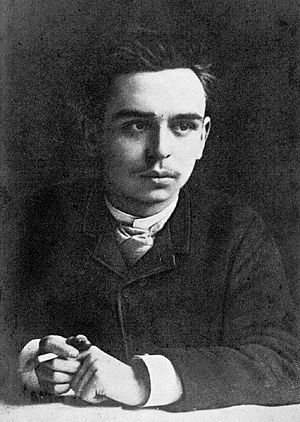Guillaume Lekeu facts for kids
Guillaume Lekeu was a talented Belgian composer. He was born on January 20, 1870, and sadly passed away on January 21, 1894, just one day after his 24th birthday. Even though he lived a short life, he created many beautiful musical pieces.
Contents
His Early Life and Music
Guillaume Lekeu was born in Heusy, a small village near Verviers, Belgium. He started learning piano and music theory from Alphonse Voss. Voss was the director of the local brass band. In 1879, when Guillaume was nine, his family moved to Poitiers, France.
He kept studying music on his own while he was at school. He wrote his very first piece of music when he was 15 years old. From 1885 onwards, he regularly composed new music. He especially enjoyed writing chamber music, which is music for a small group of instruments. He also studied harmony and violin starting in 1887.
Moving to Paris and New Teachers
In June 1888, Lekeu's family moved to Paris, France. There, he began to study philosophy. He discovered the works of Téodor de Wyzewa, who became an important friend and supporter.
In August 1889, Lekeu traveled to Bayreuth, Germany. He went there to experience the operas of Richard Wagner, a famous German composer. When he returned, he took private lessons in counterpoint and fugue with César Franck. These are advanced ways of writing music. Franck encouraged Guillaume to keep composing.
After Franck passed away in 1890, Wyzewa introduced Lekeu to Vincent d'Indy. D'Indy taught him orchestration, which is the art of arranging music for an orchestra. D'Indy also encouraged him to enter the Belgian Prix de Rome competition. This was a big music competition held in Brussels. In 1891, Lekeu won second prize for his cantata (a type of vocal music) called Andromède.
Famous Works and Final Years
In 1892, d'Indy introduced Lekeu to Octave Maus, who was part of a group called Le Cercle des XX in Brussels. A famous violinist named Eugène Ysaÿe asked Lekeu to write a piece for him. This piece became the Violin Sonata in G major. It was first performed in March 1893. This sonata is Lekeu's most famous work and is still played and recorded often today.
Sadly, Lekeu became very ill in October 1893. He caught typhoid fever from some contaminated food. He passed away at his parents' home in Angers, France, on January 21, 1894. He was buried in a small cemetery in Heusy, the village where he was born.
Lekeu's Musical Style
Lekeu's unique musical style was clear even in his earliest compositions. In 1887, he said that his music might be "weird, mad, horrible," but at least it would be "original."
His string quartets were inspired by the great composer Ludwig van Beethoven. Hearing Wagner's operas also changed how he thought about writing melodies. He liked to create "melodies of such length that a single presentation was sufficient to complete a piece of music."
His main influence was his teacher, César Franck. Many of Lekeu's works have a certain sad or thoughtful feeling. He once said that "joy is a thousand times harder to paint than suffering."
Lekeu's longer pieces often use a cyclic structure. This means that musical themes or ideas will appear again and again throughout different parts of the work. This was a common technique used by many composers in the 1800s, including Franck and d'Indy. Some people think that Lekeu's violin sonata might have inspired the imaginary "Vinteuil Sonata" described by Marcel Proust in his famous novel In Search of Lost Time.
Lekeu's style was quite advanced for his time. It even hinted at the music of early 20th-century French composers like Erik Satie and Darius Milhaud. He was influenced by Franck, Wagner, and Beethoven, but he didn't just copy them. He created his own sound. Many people believe that Lekeu was a very talented composer whose early death stopped a promising musical career.
His Compositions
Guillaume Lekeu composed about 50 pieces of music. He also left several unfinished works when he died. Two of these, a Cello Sonata and his Piano Quartet, were finished by his teacher, Vincent d'Indy. Many of his works have been recorded, especially his Violin Sonata in G Major and his Piano Trio in C minor.
Some of his important works include:
Music for Voices
- Chant lyrique, for chorus and orchestra (1891)
- Andromède, a cantata for singers, chorus, and orchestra (1891)
Songs
- Two poems by Lamartine, for voice and piano (1887)
- Chanson de Mai, for voice and piano (1891)
- Trois Poèmes, for voice and piano (1892)
Music for Orchestra
- Introduction symphonique aux Burgraves, an overture for orchestra (1889)
- Hamlet. Étude symphonique, for orchestra (1890)
- Fantaisie sur deux airs populaires angevins (Fantasy on two Angers folktunes), for orchestra (1892)
Chamber Music
- Quatuor (String Quartet) in G major (1888)
- Trio pour piano, violon et violoncelle (Piano Trio) in C minor (1889–91)
- Sonate pour piano et violon (Violin Sonata) in G major (1892–93)
- Quatuor a clavier (Piano Quartet) in B minor (1892–94)
Piano Music
- Morceaux égoïstes, for piano (7 pieces) (1887–88)
- Sonate (Piano Sonata) in G minor (1891)
- 3 Pièces, for piano (1892)
See also
 In Spanish: Guillaume Lekeu para niños
In Spanish: Guillaume Lekeu para niños


